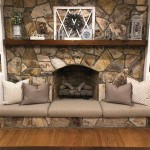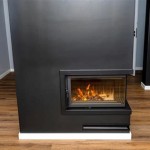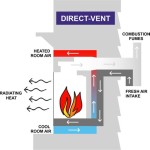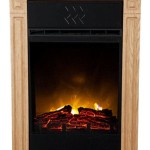The Enduring Charm of Old Wood Fireplace Surrounds
Old wood fireplace surrounds, often imbued with history and craftsmanship, offer a distinct aesthetic appeal that sets them apart from modern alternatives. Their enduring popularity stems from a combination of factors, including the character of aged wood, the diversity of styles available, and their potential to serve as a focal point in a room. Understanding the nuances of these surrounds, from their historical context to proper maintenance, is essential for anyone considering incorporating one into their home.
The term "old" encompasses a wide range of time periods and construction techniques. Some surrounds may date back to the Victorian era, characterized by elaborate carvings and intricate details, while others might originate from the early 20th century, showcasing simpler, more streamlined designs influenced by the Arts and Crafts movement. Regardless of their specific provenance, these surrounds share a common thread: they represent a tangible connection to the past, offering a glimpse into the design sensibilities of previous generations.
The value of an old wood fireplace surround extends beyond mere aesthetics. It represents a piece of architectural history, often crafted with materials and techniques rarely employed in contemporary construction. The wood itself, typically sourced from old-growth forests, possesses a density and grain pattern that is unmatched by newer lumber. This contributes to the surround's structural integrity and its resistance to warping and cracking over time.
Historical Context and Design Styles
The history of fireplace surrounds is inextricably linked to the evolution of heating technology. Prior to the widespread adoption of central heating, fireplaces served as the primary source of warmth in homes. Consequently, the surround played a crucial role in both directing heat into the room and protecting the surrounding walls from fire. As fireplace technology evolved, so too did the design of the surrounds.
Victorian fireplace surrounds, for example, often featured ornate carvings, incorporating motifs such as flowers, foliage, and mythical creatures. These designs reflected the Victorian era's emphasis on embellishment and its fascination with the natural world. The wood used was frequently mahogany or walnut, prized for their rich color and fine grain. These surrounds were often stained dark to further enhance their perceived opulence.
In contrast, Arts and Crafts fireplace surrounds embraced simplicity and functionality. Characterized by clean lines, geometric patterns, and a preference for natural materials, these surrounds reflected the Arts and Crafts movement's rejection of mass-produced goods and its celebration of handcrafted items. Oak and other native hardwoods were commonly used, and the finishes were typically lighter and more natural, allowing the beauty of the wood grain to shine through.
Another significant design style is the Federal style, prevalent in the late 18th and early 19th centuries. Federal surrounds often feature delicate carvings, fluted columns, and symmetrical designs, drawing inspiration from classical architecture. These surrounds typically used lighter woods, such as pine or poplar, and were often painted in light, neutral colors to complement the refined aesthetic of the Federal period.
Identifying the specific design style of an old wood fireplace surround can provide valuable insights into its historical context and its potential value. Antique dealers and architectural salvage yards are often knowledgeable resources for identifying and dating these items. Examining the construction techniques, the type of wood used, and the stylistic motifs can all contribute to a more accurate assessment of the surround's origins.
Material Considerations and Restoration
The type of wood used in an old fireplace surround significantly impacts its appearance, durability, and value. As previously mentioned, mahogany and walnut were popular choices for Victorian surrounds, while oak and other hardwoods were favored during the Arts and Crafts period. Pine and poplar were common in Federal-style surrounds due to their availability and ease of carving.
Understanding the characteristics of different wood species is crucial for proper restoration. Mahogany, for instance, is known for its rich, reddish-brown color and its resistance to decay. Walnut, on the other hand, is prized for its dark, chocolate-brown hue and its fine grain. Oak is a strong and durable wood with a distinctive grain pattern, while pine is a softer wood that is more susceptible to damage.
Restoring an old wood fireplace surround requires careful consideration and a delicate touch. The goal of restoration should be to preserve the surround's original character while addressing any structural issues or cosmetic imperfections. This often involves cleaning the wood, repairing any cracks or damage, and applying a suitable finish.
Harsh cleaning agents should be avoided, as they can damage the wood and strip away its original finish. Instead, a mild soap and water solution, followed by a thorough drying, is generally recommended. For stubborn dirt or grime, a specialized wood cleaner formulated for antique furniture can be used. It is advisable to test any cleaning product on an inconspicuous area of the surround before applying it to the entire surface.
Repairing cracks or damage may require the expertise of a professional woodworker. Filling cracks with wood filler or epoxy resin can help to restore the surround's structural integrity and prevent further damage. Replacing missing pieces or damaged carvings may require custom fabrication, which can be a time-consuming and expensive process. However, the end result can be a beautifully restored fireplace surround that will last for generations.
The choice of finish is another important consideration. While some homeowners prefer to strip the surround down to its bare wood, others opt to preserve the original finish. If the original finish is in good condition, it can be cleaned and waxed to protect it from further damage. If the finish is damaged or deteriorated, it may need to be removed and replaced with a new finish. A variety of finishes are available, including varnishes, lacquers, and oils. The choice of finish will depend on the type of wood, the desired aesthetic, and the level of protection required.
Installation and Maintenance
Installing an old wood fireplace surround requires careful planning and attention to detail. It is essential to ensure that the surround is properly aligned and securely attached to the wall. Depending on the size and weight of the surround, professional installation may be necessary.
Before installing the surround, it is important to inspect the fireplace and chimney to ensure that they are in good working order. Any necessary repairs or maintenance should be performed before installing the surround. This will help to prevent potential fire hazards and ensure that the fireplace operates safely and efficiently.
Once the surround is installed, it is important to maintain it properly to protect it from damage. Regular cleaning with a soft cloth will help to remove dust and dirt. Avoid using abrasive cleaners or scouring pads, as they can scratch the wood. Periodically waxing the surround will help to protect the finish and keep it looking its best.
Exposure to extreme temperatures or humidity can damage the wood. Avoid placing the surround near sources of heat or moisture. If the surround is located in a humid environment, consider using a dehumidifier to help control the humidity level. Similarly, if the surround is located in a dry environment, consider using a humidifier to help prevent the wood from drying out and cracking.
Inspecting the surround regularly for signs of damage is also important. Look for cracks, warping, or insect infestations. Addressing these issues promptly can help to prevent further damage and extend the life of the surround. If you notice any signs of damage, consult with a professional woodworker or restoration specialist to determine the best course of action.
Proper installation and maintenance are essential for preserving the beauty and value of an old wood fireplace surround. By following these guidelines, homeowners can enjoy the enduring charm of these historical artifacts for many years to come.

Rustic Fireplace Mantels Barn Beam Olde Wood Reclaimed Mantel

Reclaimed Wood Fireplace Create A Sunning Surround

Custom Rustic Cau Mantel 100 Year Old Reclaimed Wood Full Surround Fireplace With Legs And Inside Corners Real Beam

Reclaimed Wood Fireplace Mantel 100 Year Old Rustic Beam Customizable Size Color With Corbels Real

Reclaimed Mantel Dakota Timber Co Fireplace Mantels

Barnwood Fireplace Mantel The Collection

Beautiful Rustic Fireplace Mantels Made From Reclaimed Barn Beams

Conrad Cast Stone Fireplace Mantel Old World Stoneworks

Restoration Resources New England S Primary Source For Authentic Architectural Antiques Wood Mantels Section

Cozy Fireplace With Stylish Design
Related Posts








